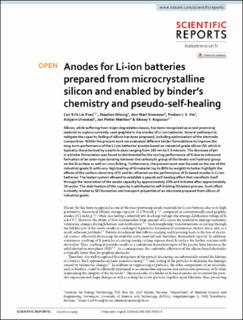| dc.contributor.author | Foss, Carl Erik Lie | |
| dc.contributor.author | Stephan, Müssig | |
| dc.contributor.author | Svensson, Ann Mari | |
| dc.contributor.author | Vie, Preben Joakim Svela | |
| dc.contributor.author | Ulvestad, Asbjørn | |
| dc.contributor.author | Mæhlen, Jan Petter | |
| dc.contributor.author | Koposov, Alexey | |
| dc.date.accessioned | 2020-08-19T08:15:43Z | |
| dc.date.available | 2020-08-19T08:15:43Z | |
| dc.date.created | 2020-08-06T23:01:55Z | |
| dc.date.issued | 2020 | |
| dc.identifier.citation | Scientific Reports. 2020, 10, | en_US |
| dc.identifier.issn | 2045-2322 | |
| dc.identifier.uri | https://hdl.handle.net/11250/2672923 | |
| dc.description.abstract | Silicon, while suffering from major degradation issues, has been recognized as a next promising material to replace currently used graphite in the anodes of Li-ion batteries. Several pathways to mitigate the capacity fading of silicon has been proposed, including optimization of the electrode composition. Within the present work we evaluated different binder formulations to improve the long-term performance of the Li-ion batteries’ anodes based on industrial grade silicon (Si) which is typically characterized by a particle sizes ranging from 100 nm to 5.5 microns. The decrease of pH in a binder formulation was found to detrimental for the cycling performance of Si due to enhanced formation of an ester-type bonding between the carboxylic group of the binder and hydroxyl group on the Si surface as well as cross-linking. Furthermore, the present work was focused on the use of the industrial grade Si with very high loading of Si material (up to 80% by weight) to better highlight the effects of the surface chemistry of Si and its influence on the performance of Si-based anodes in Li-ion batteries. The tested system allowed to establish a pseudo self-healing effect that manifests itself through the restoration of the anode capacity by approximately 25% and initiates after approximately 20 cycles. The stabilization of the capacity is attributed to self-limiting lithiation process. Such effect is closely related to SEI formation and transport properties of an electrode prepared from silicon of industrial grade. | en_US |
| dc.language.iso | eng | en_US |
| dc.publisher | Nature Research | en_US |
| dc.rights | Navngivelse 4.0 Internasjonal | * |
| dc.rights.uri | http://creativecommons.org/licenses/by/4.0/deed.no | * |
| dc.title | Anodes for Li‑ion batteries prepared from microcrystalline silicon and enabled by binder’s chemistry and pseudo‑self‑healing | en_US |
| dc.type | Peer reviewed | en_US |
| dc.type | Journal article | en_US |
| dc.description.version | publishedVersion | en_US |
| dc.source.pagenumber | 8 | en_US |
| dc.source.volume | 10 | en_US |
| dc.source.journal | Scientific Reports | en_US |
| dc.identifier.doi | 10.1038/s41598-020-70001-5 | |
| dc.identifier.cristin | 1822123 | |
| dc.relation.project | Norges forskningsråd: 255195 | en_US |
| dc.relation.project | Norges forskningsråd: 257653 | en_US |
| dc.description.localcode | Open Access This article is licensed under a Creative Commons Attribution 4.0 International License, which permits use, sharing, adaptation, distribution and reproduction in any medium or format, as long as you give appropriate credit to the original author(s) and the source, provide a link to the Creative Commons license, and indicate if changes were made. The images or other third party material in this article are included in the article’s Creative Commons license, unless indicated otherwise in a credit line to the material. If material is not included in the article’s Creative Commons license and your intended use is not permitted by statutory regulation or exceeds the permitted use, you will need to obtain permission directly from the copyright holder. To view a copy of this license, visit http://creativecommons.org/licenses/by/4.0/. | en_US |
| cristin.ispublished | true | |
| cristin.fulltext | original | |
| cristin.qualitycode | 1 | |

